Some of the best things about an ed-tech conference are the sessions, where attendees learn about new tools and resources, trends, and teaching strategies. But you can’t make it to every session, and sometimes it’s hard to choose when each session is compelling and relevant to your educational needs.
That’s where eSchool News can help. During the many conference we attend, our editorial team heard from real educators who shared real experiences in their classrooms and with students.
We’ve put together a list of apps, tools and resources from these educators:
1. Numbers for iPad [1] lets users create spreadsheets that include charts, text, images, and tables. The iPad app is collaborative and lets a group of users work together in real time.
2. Nepris [2] connects educators and students to industry experts through web-based chat sessions about careers, topics and concepts students wish to learn more about.
3. Nearpod [3] is an interactive classroom tool to help teachers engage and assess students. Teachers can create and customize the interactive lessons or can download other resources.
(Next page: 12 more resources from real educators)
4. The Shadowpuppet [4] app helps students create videos of work samples, provide voice recordings, and put pictures with text.
5. Recap [5], which teachers could use to ask students to summarize chapters from assigned reading, is a video response reflection tool that lets students respond to prompts from their teachers.
6. Seesaw [6] is a learning journal that empowers students to keep track of their learning and create digital portfolios. Students are able to share their work with peers and parents.
7. Qball [7] is a throwable, wireless microphone that is soft and fun for students to use. It could make speaking in front of class a bit more fun and less intimidating for nervous students, and it also mutes automatically when in motion.
8. Visuwords [8] shows students the definitions of and connections between words via a web design and a color-coded key.
9. TeleStory [9] lets students write, direct and star in their own television show, commercial or informative video. They can choose from themes and digital costumes.
10. GeoGebra [10] is mathematics software that brings together geometry, algebra, spreadsheets, graphing, statistics and calculus.
11. Using Swipespeare [11], students can convert Shakespearean language into plain English with a single swipe.
12. Along the same lines as Swipespeare, Rewordify [12] simplifies difficult English words. Students copy and paste sentences, paragraphs, whole chapters or web addresses into the site and difficult words are highlighted with synonyms. The site also offers vocabulary-building exercises and reading comprehension skills.
13. Arduino [13], suited for makerspaces or STEM labs, is an open-source electronic prototyping platform enabling users to create interactive electronic objects.
14. 3Doodler [14] is a 3D pen with a plastic filament output that is molded into a 3D representation of what users draw.
15. Socratic [15] offers homework answers and math help. Students can take a photo of their math problems and get instant step-by-step help.
